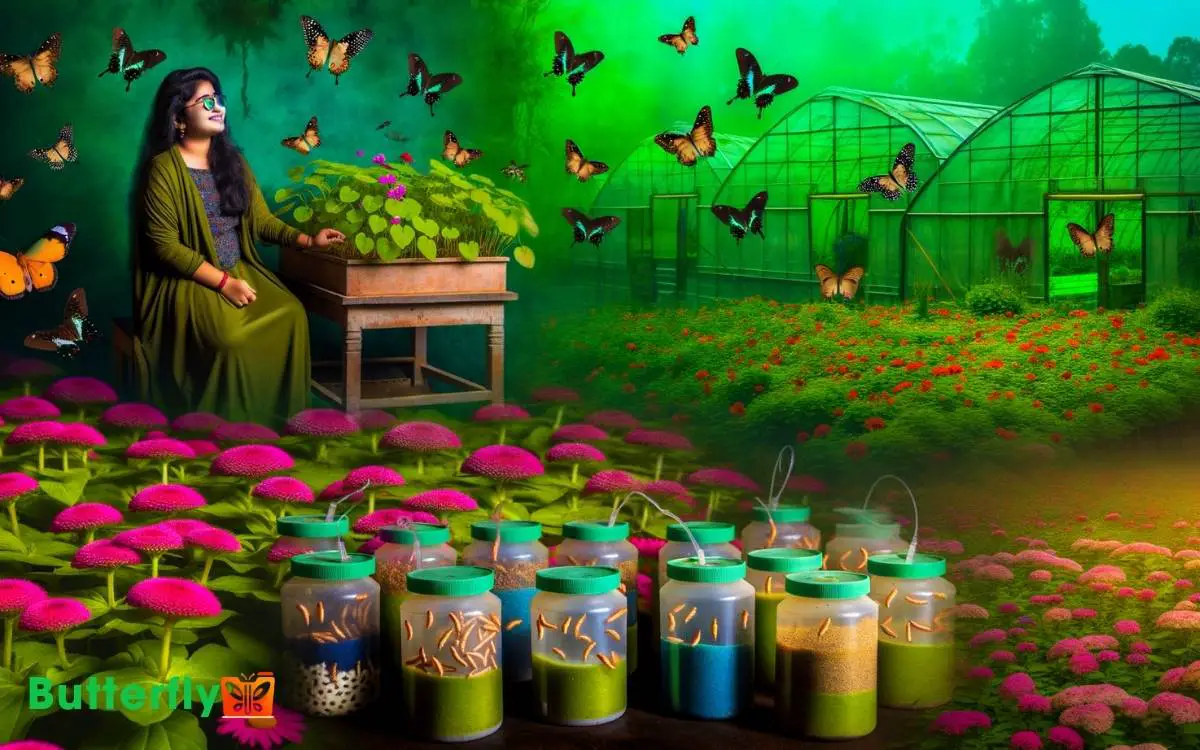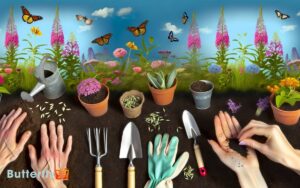How To Start A Butterfly Farm? Comprehensive Guide!
To start a butterfly farm, choose native species tailored to your climate. Focus on polyphagous species for adaptability and high fecundity.
Set up a habitat with native plants, water sources, and shelters like dense foliage. Make sure your environment supports all life stages from larvae to adults.
Provide shallow water dishes and maintain their cleanliness. Use rearing containers and controlled-environment chambers for precise growth conditions.
Understand legal regulations and obtain necessary permits. Promote your farm through social media and educational programs. Stay tuned to learn how to transform your space into a vibrant butterfly sanctuary.

Key Takeaways
Choosing the Right Species
When selecting the appropriate species for your butterfly farm, it’s crucial to take into account both the local climate and the specific host plants that cater to the dietary needs of the caterpillars.
Research native butterfly species that thrive in your region’s temperature and humidity levels. Consider the phenology of plants, focusing on those that provide the best nutrition at various stages of the caterpillar’s growth cycle.
Opt for polyphagous species, which feed on multiple plant types, to enhance adaptability. Observe the interaction between butterflies and their environment; note which species exhibit higher fecundity rates and resistance to local pathogens.
Setting Up the Habitat
When setting up the habitat, choose native plants that cater to both larvae and adult butterflies, ensuring a continuous food supply.
Install water sources like shallow dishes with pebbles to provide hydration without the risk of drowning.
Additionally, create shelter options using dense foliage or butterfly houses to protect them from predators and harsh weather.
Selecting Native Plants
To create a thriving butterfly habitat, focus on selecting native plants that cater to the specific species you aim to attract and support.
Native plants provide the essential nectar and host plants for caterpillars and butterflies. You’ll need to observe local butterfly species and their plant preferences.
Consider these key factors:
- Host Plants: Select species-specific host plants for caterpillar development, like milkweed for Monarchs.
- Nectar Sources: Incorporate a variety of flowering plants with staggered bloom times to guarantee a continuous nectar supply.
- Microhabitats: Create diverse environments with sun, shade, and shelter to meet various butterfly needs.
- Plant Density: Maintain high plant density to optimize habitat complexity and resource availability.
Providing Water Sources
Ensuring your butterfly farm includes reliable water sources is essential for providing hydration and supporting the life cycles of both butterflies and their caterpillars. A well-planned butterfly watering station setup can include shallow dishes with damp sand or sponges soaked in water to provide a safe drinking source. Placing these stations in shaded areas helps prevent water from evaporating too quickly while keeping the butterflies cool. Additionally, adding natural materials like rocks or twigs gives butterflies a place to perch as they drink.
You’ll need to establish shallow water features, like birdbaths or puddling stations, where butterflies can safely drink. Butterflies prefer muddy or sandy areas for puddling, which allows them to absorb crucial minerals.
To innovate, consider using automated misting systems to create a microclimate that mimics natural dew, enhancing hydration without standing water. Observational insights suggest placing pebbles or sponges in water dishes to prevent drowning.
Monitor these water sources regularly, ensuring cleanliness and replenishment.
Deploying diverse water features will create a dynamic habitat, fostering a thriving butterfly population while integrating seamlessly with your farm’s ecosystem.
Ensuring Shelter Options
Creating a conducive habitat for butterflies involves strategically planting native flora that provides shelter and food sources throughout their life cycle. You’ll need to guarantee a diverse array of plants to cater to both larvae and adult butterflies.
Positioning taller plants and shrubs can offer protection against wind and predators, while ground cover plants provide safety for caterpillars.
Consider incorporating:
- Host Plants: Essential for laying eggs and feeding larvae.
- Nectar Plants: Provide sustenance for adult butterflies.
- Microhabitats: Small, sheltered areas that mimic natural environments.
- Water Sources: Shallow dishes or puddling stations to meet hydration and nutrient needs.
Understanding the Lifecycle
The lifecycle of a butterfly, encompassing the stages of egg, larva, pupa, and adult, offers fascinating insights into metamorphosis and adaptation.
You’ll observe the intricacies of each phase: from the delicate eggs laid on host plants to the voracious larva, or caterpillar, that undergoes multiple instars.
During the pupal stage, the chrysalis undergoes a profound transformation, known as histolysis and histogenesis, where larval structures are broken down and adult features form.
Finally, the adult emerges, ready to pollinate and propagate. Understanding these stages helps you innovate care strategies, ensuring ideal health and sustainability.
Monitor temperature, humidity, and host plant availability to replicate natural conditions, promoting successful metamorphosis and a thriving butterfly population.
Sourcing Necessary Supplies
Where can you find the essential supplies to establish a successful butterfly farm?
You can start by sourcing caterpillar rearing containers and larval food plants, ensuring a steady supply of host plants.
Additionally, you’ll need to invest in controlled-environment chambers to maintain the best temperature and humidity levels.
For the pupation stage, provide specialized pupation boxes and substrates.
- Caterpillar rearing containers: Transparent, ventilated containers for observing growth stages.
- Larval food plants: Host plants specific to your butterfly species.
- Controlled-environment chambers: Maintain temperature and humidity for ideal growth.
- Pupation boxes and substrates: Secure environments for chrysalis formation.
Using these materials, you can create an innovative, scientifically grounded butterfly habitat.
Navigating Legal Requirements
Before you can start your butterfly farm, it’s crucial to understand and comply with the legal regulations that govern the breeding and sale of butterflies in your region.
Different jurisdictions have specific requirements to protect native species and ecosystems. You must research local, state, and federal laws, as these can vary greatly.
| Regulatory Aspect | Description |
|---|---|
| Permits | Necessary for breeding, selling, and transporting |
| Species Restrictions | Limits on non-native or endangered butterflies |
| Inspections | Regular checks to ensure compliance |
| Record-Keeping | Documentation of breeding and sales activities |
| Environmental Impact | Assessments to prevent ecological disruption |
Consult with regulatory bodies, such as the U.S. Fish and Wildlife Service, to make sure all legalities are addressed. This diligence will safeguard your farm’s sustainability and ecological integrity.
Marketing Your Butterfly Farm
After ensuring compliance with all legal requirements, you can now focus on effectively marketing your butterfly farm to attract enthusiasts and potential buyers.
Leverage innovative strategies to highlight the unique aspects of your farm. Utilizing scientific terminology and observational insights can differentiate your farm and captivate a knowledgeable audience.
- Social Media Campaigns: Showcase metamorphosis stages, host live Q&A sessions, and share high-resolution images of rare species.
- Collaborations: Partner with botanical gardens, schools, and eco-tourism groups to expand your reach.
- Workshops and Tours: Offer educational workshops on butterfly life cycles, and guided tours emphasizing habitat conservation.
- Online Presence: Build an informative website with a blog detailing your breeding techniques and conservation efforts.
Conclusion
So, you’ve decided to start a butterfly farm, huh?
Ironically, you’ll be dealing with more science than splendor. From understanding metamorphosis to sourcing specialized nectar plants, every detail matters.
And don’t forget the legal hoops you’ll jump through yes, even butterflies have bureaucratic red tape.
But hey, when you’re watching a fragile monarch emerge from its chrysalis, the irony of all the hard work will flutter away.
Who knew farming could be so… delicate?






